공지사항
-
- '노란봉투'캠페인/국제연대..
- no chr.!
5112개의 게시물을 찾았습니다.
Well, it seems that Pyeongyang is really earnestly preparing the proposed (by the "Dear Leader", resp. "Supreme Leader" Himself) bilateral negotiations with Washington(*), as you can learn from following newslet by yesterday's Yonhap:
"North Korea vowed Wednesday not to be bound by the latest United Nations resolution on non-proliferation and disarmament, saying it will never give up its nuclear weapons under any circumstance."
* Washington's final goal, according to the Obama administration, for possible bilateral negotiations with Pyeongyang: Bringing back N.K. to the 6-Party-Talks in Beijing and its complete nuclear disarmament...
Yep, it seems that the U.S. and N.K. have now a common basis for... whatever!^^
But possibly not for bilateral negotiations...
Yeah, exactly!!^^
Related stuff:
☞ U.S. delays bilateral dialogue with N.Korea (Hankyoreh, 10.1)
☞ Wen Jiabao holds key to nuke talks (K. Herald, 10.1)
☞ S. Korean Chief Executive's "Proposal" is Rubbish (KCNA, 9.30)
60年風雲:毛時代的中國記憶
Tomorrow sees the 60th anniversary of the creation of the People's Republic of China. Here, in today's Guardian(UK), four people, all once committed members of the ruling Communist party, recall their part in its creation:
☞ Sixty years on: veterans of Chairman Mao's China remember

Last week(9.25) Yonhap reported following:
The labor union of Korea's largest automaker, Hyundai Motor Co., elected today Lee Kyung-hun, a moderate figure, as its new leader in a tightly contested race, company and union officials said, signaling a change in the body's often militant approach.
Lee Kyung-hun, who sought to represent centrist and pragmatic forces in the Hyundai Motor union while vowing to improve employee welfare, won 52.56 percent of 40,288 votes cast, defeating rival candidate Kwon O-il, who grabbed 46.98 percent of the votes, said the officials.
Throughout his campaign, Kwon had pledged to fight against the government's labor policies.
This is the first time in 15 years that the Hyundai Motor union has elected a moderate figure as its leader.
Lee, 49, focused his campaign on appealing to unionized workers fed-up with the current leadership's anti-government stance under the guidance of the umbrella Korean Metal Workers' Union.
One day later the "left"-liberal Hankyoreh newspaper wrote: "The outcome of Hyundai Motor chapter’s election suggests changes are in store for KMWU, and possibly broader labor movement strategy."
Yesterday Hankyoreh spoke with Chung Kap-deuk (KMWU) about the issue:
(Hyundai Motors) Unions’ decisions to elect moderates as leaders raises questions about South Korean labor movement’s direction
Regarding the new union leadership elections in Hyundai Motors that have taken place this month, Chung Kap-deuk, the chairperson of the Korean Metal Workers’ Union (KMWU), one of the core unions in the Korea Confederation of Trade Union (KCTU), granted the Hankyoreh an exclusive interview during the evening of Sept. 27 at the KMWU office located in Seoul’s Yeongdeungpo neighborhood.
Hankyoreh: What is your opinion about the Hyundai Motor Union’s decision to elect a pragmatic moderate for the first time in nearly 15 years? And, what are KMWU’s thoughts on eliminating the current company-based chapters and reorganizing them into regional chapters?
Chung: “This has proven that the umbrella union’s leadership of its branch unions has been ineffective for the labor movement. It is time for us to re-examine the way we organize and to decide whether we need to adopt some changes.”
This is first time that a core leader in the KCTU expressed the idea that the current operations of the labor movement could be changed.
Hankyoreh: What can you tell us about the proposal for developing an industrial union?
Chung: “If we cannot build a strong industrial union, the labor movement will be unsuccessful and our members will be powerless. Moreover, if we stick to the labor movement’s current strategy of organizing, we may lose in the Kia Motor Union election.”
Hankyoreh: What are your thoughts on the Hyundai Motors Union election of Lee Gyeong-hun, the moderate candidate and winner?
Chung: “The current leadership of the Hyundai Motors Union has been placed in a difficult position, but it has not done much to proactively remedy the situation. We should reflect on the mistakes labor has made and become more flexible. We should put our energy into educating union members in order to better communicate.“
http://english.hani.co.kr/arti/english_edition/e_national/379270.html
Related articles:
☞ First moderate S. Korean union head elected in 14 years (Hankyoreh, 9.26)
☞ Hyundai Motor at crossroads ("editorial" by JoongAng Ilbo, 9.26)
Fairyland News Agency, aka KCNA, published last Friday following
Report on Shining Successes Made in 150-day Campaign
The Korean Central News Agency released a report Thursday in connection with the shining victory won by the army and people of the DPRK in the 150-day campaign.
According to the report, the campaign plan was carried out at 112 percent, taking the country as a whole.
The industrial production showed a 1.2-fold increase over that in the same period last year and hundreds of objects were commissioned or underwent technological updating in that period... (and so on ad nauseam...)
The shining victory of the 150-day campaign goes to clearly prove the great Songun revolutionary leadership of Kim Jong Il.
http://www.kcna.co.jp/item/2009/200909/news25/20090925-03ee.html
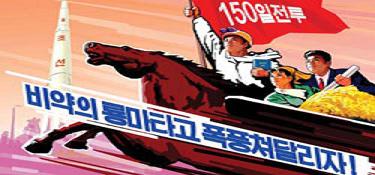
Well, the 150-day Battle campaign has been soooo successful that it will be followed by a 100-day Battle campaign until - at least - December(*)!
But very likely the reality is a little bit different! At least according to all the defeatists(^^) in S.K. and the rest of the world it's just the consequence of the miserably result of the 150-day Battle campaign...
Anyway, North Korea Economy Watch has a bitching collection of
☞ “150 Day Battle” production campaign stories
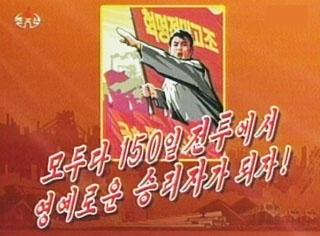
* Related stuff:
☞ N.K. extends labor drive by 100 days (K. Herald, 9.21)
☞ 100-Day Battle to Add to Popular Woes (DailyNK, 9.14)
Here some impressions from yesterday's Memorial Rally for the Victims of the Yongsan Massacre, held in front of Seoul Stn. where more than 1000 people - resistance activists, workers, students and "ordinary" citizens - participated:
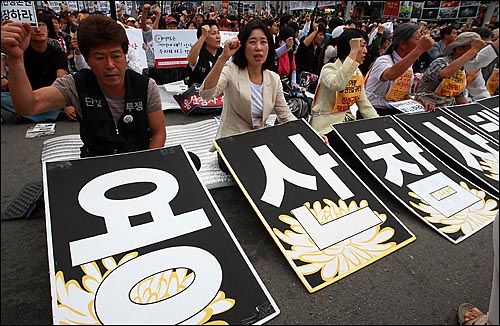
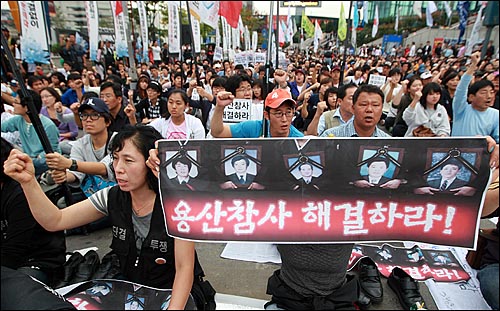

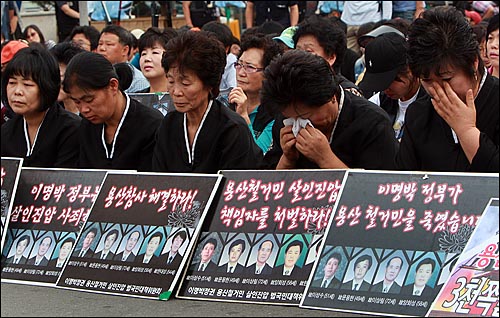

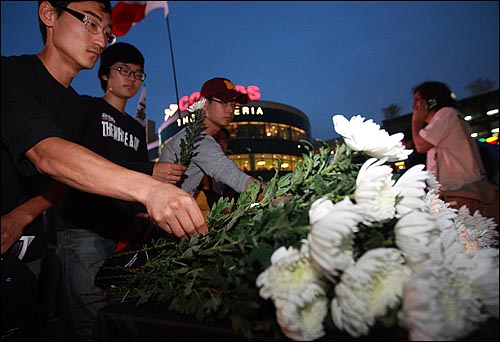
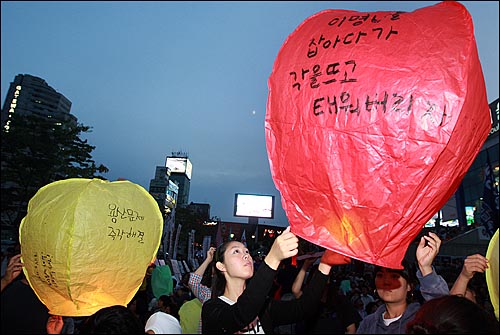
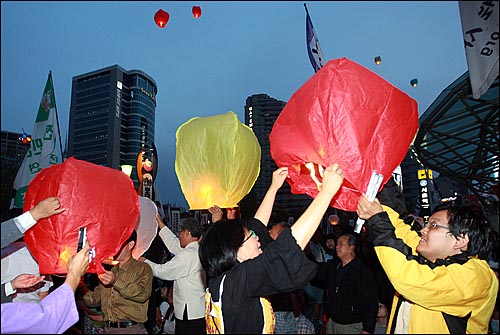
Source of the pics: OMN, TiN
Related reports by: ☞ VoP ☞ OMN ☞ TiN ☞ KCTU
More photo impressions you can see here. And finally here you can watch a video about yesterday's rally.
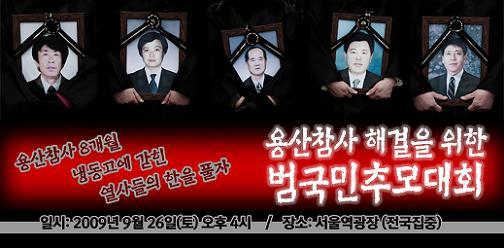
Related essay:
Heading to Yongsan
by Hong Se-hwa
Yongsan again? It is still Yongsan, and it must continue to be Yongsan until the day comes. Why is it that I, that we, cannot ever escape from Yongsan?
Every night except Thursday at 7:00 p.m. a group of Catholic priests hold mass in memory of the victims at the scene where the Yongsan tragedy occurred... Perhaps because of the small number of participants, the evening wind feels harsh and chilly as it winds its way through the street by the Namildang Building where the tragedy took place. During my first visit, in what has been a longtime, I heard the roar of Father Moon Jung-hyun, who was presiding over the scene. If just a tenth, or even a hundredth, of the people who came to pay their respects to the late Cardinal Kim Sou-hwan, Roh Moo-hyun or Kim Dae-jung were in attendance here, he cried, the Yongsan problem could be solved. Father Moon then lamented over the fact that in spite of the many intellectuals, cultural figures and journalists talking about Yongsan in the newspapers and other public forums, few have actually come to visit the site.
Is it because it is inconvenient, as some have suggested, that people merely talk about Yongsan and do not visit? People may seek comfort, but humanity typically demands that we accept discomfort. Isn’t what makes us human the fact that we may be able to step away from humanity momentarily for the sake of comfort, but we cannot escape it forever? And those who say they do not attend the masses or services because they have no religion or a different religion are merely presenting convenient excuses. Their reasons stem from somewhere else. Is it not because we have gotten used to thinking of ourselves first, discussing the society that causes these incidents rather than sharing our neighbors’ pain and misfortune? Can I truly say that I am not assuaging my own wounded conscience when I talk about Yongsan, rather than looking unflinchingly at and offering comfort to the grisly wounds that still linger there?
It is also true, however, that a feeling of rage takes precedence over the spirit of sharing in our neighbors’ suffering. Think of Lee Sang-rim, owner of the Hangang Galbi restaurant. On Jan. 18, he ascended the Namildang tower together with his son, who was head of the protest committee against demolition. Lee, a 71-year-old grandfather was deemed an “urban terrorist,” and he burned to death in a suppression operation by a police commando unit not one day after he climbed the tower. Eight months have passed without even a funeral service. No one has taken responsibility. No one is apologizing. The prosecutors have refused to disclose some 3,000 pages of investigation records, claiming that the content is unrelated to the trial. When public authorities arbitrarily make determinations and decisions, this is called absolutism and it is the relic of a bygone era. Yet, a trial is underway now in which the surviving family members sit in the defendants’ box.
The “four major rivers” are not the only victims of the Lee Myung-bak administration’s tsunami. The knife-edge of illiberality is dancing in all areas of labor, education, human rights, media, welfare and civil society. Everyone that is not an ally is an adversary to be overcome through arrest and detention, dismissal and termination, hunting and litigation, monitoring and surveillance. Such is the situation that the targets even include Hope Institute Executive Director Park Won-soon, a creative man whose actions are far from subversive. Bridgeheads of democracy in all areas of society that have been built up with great effort are now collapsing, and it has become almost beyond people’s capacity to guard and preserve their sectors. This is likely another reason we see so few visiting Yongsan.
Yongsan is a self-portrait of our distorted society, the front lines on which we must fight those who oppose democracy and human rights. If we cannot maintain this line, we will be unable to advance in any area. Until the government apologizes, until the 3,000 pages of investigation records are revealed, until at least some measure of comfort is given to the souls of those who lost their lives so horribly and address their family members’ bitterness, we must continue to talk about Yongsan. More than that, we must visit Yongsan. Actions rather than words, bodies rather than mouths. If those of us who met last year in the plaza during the candlelight vigil demonstrations could meet again at Yongsan... What humbled the Lee Myung-bak administration last year was not words, but the power of our candlelight.
Source: Hankyoreh (9.23)
http://english.hani.co.kr/arti/english_edition/e_opinion/378222.html
Editorial in today's Hankyoreh:
On KCTU and Lee government’s next steps
The Korean Government Employees’ Union (KGEU), the Korean Democracy Government Employees’ Union (KDGEU) and the Court Government Employees’ Union (CGEU) have decided to merge and join the Korean Confederation of Trade Unions (KCTU). An estimated 89.6 percent of the total union membership voted to merge the three unions together, and 68.4 percent voted to join the KCTU. The vote began on Sept. 21 and took place over a period of two days. The voting results stand in defiance of pressure from the Lee administration and the ruling Grand National Party (GNP) that had taken the form of threatening statements prior to the vote. It would not be an overstatement to view the result as an expression of the unionists’ keenly felt need to unify and act in solidarity.
Ultimately, the decision to join the KCTU is more striking than the decision to unify. This is because since the beginning of this year, a significant number of unions have fled the KCTU, and the Lee government’s assault on the KCTU has reached a higher intensity than ever. Why would civil servants, who are viewed as being relatively conservative, join the KCTU? Perhaps the main reason is opposition against the current government’s openly anti-union policies, and among those, the pressure for structural adjustment that disproportionately affects civil servants. The current ruling government has pushed civil servants into a corner while promoting business efficiency, as if the government was managing a corporation and could neglect the public nature of government bodies. One could easily predict that the unhappiness and hostility towards this trend would be greater among lower-ranking civil servants.
The Lee government, however, does not appear to be at all ready to reflect on the significance of the government employees’ decision to join the KCTU. Instead, the Lee administration and GNP fired off an assortment of threatening statements prior to the vote. They even heaped scorn on the civil servant unions and said they could become an organ of the KCTU leadership if they joined the umbrella union. There has been no change in the attitude of the Lee government since the results of the vote came in. Yesterday, related ministers, including the Minister of Public Administration and Security, issued a joint statement attacking the KCTU and civil servant unions. They did not hesitate to make statements aimed at causing internal fissures in the union by claiming concern that the many civil servants who had engaged in union activity in good faith would be hurt by the vote’s results. The government’s action certainly does not legitimate their right to speak about rational labor-management relations through dialogue and compromise. This is not an attitude that would have been unless its true goal is to render the unions powerless. The Lee government should reflect on its actions in order to appropriately determine who is responsible for the continuing deterioration in labor-management relations.
Meanwhile, we hope that the KCTU uses the government employees’ unions’ votes to merge and come under its umbrella as an opportunity to reflect. It must not forget that a confederation that seeks to create a world in which the laborer becomes an owner must facilitate a situation where a member organization is also an owner.
http://english.hani.co.kr/arti/english_edition/e_editorial/378456.html
A collection of related articles you'll find here (LabourStart)!
Almost 20 days ago the Korea Immigration Service(KIS, a part of the Ministry of "Justice") - better known as "S. Korean Agency for Crackdown and Mass Deportation" - announced that this year's wave of crackdown on un-documented migrant workers will take place from beginning of October until (at least) the end of November. But in reality the Crackdown Terror is already under way!
Additionally KIS announced - for the first time officially - that this year's crackdown will be joined by regional (riot)police forces and other related agencies to arrest and deport "as many illegal immigrants as possible"(!!!), according to the following article, published in yesterday's Korea Times:
Random Checks for Illegal Aliens Upset Foreigners
The Korea Immigration Service's crackdown on illegal immigrants this year has been met with controversy due to allegations its officers are making random checks on those who look like foreign workers.
Members of the legally residing foreign community are also upset at the failure to stick to a legal set of procedures.
"Immigration officials make raids on the street," said a foreign scholar in Seoul who spoke on condition of anonymity.
She said three Nepalese foreigners were grabbed on their way to get a haircut recently, while a pregnant woman was taken outside of the city last week. Others are caught during routine shopping errands, she said.
"The intense crackdown was to start from November, but it's been very terrible since September," the scholar said.
KIS spokesman Ahn Kyu-suk neither denied nor confirmed these allegations in an e-mail interview with The Korea Times, but simply cited the legal procedures.
Ahn said the Immigration Law dictates that "if foreigners residing here always carry a copy of their passport and alien registration card, the concerned shall satisfy the requirements of immigration and passport officials."
"Therefore, suspected foreigners in these circumstances must show their identification" during on-the-spot checks, the spokesman added.
"Enforcement will start in October or November," Ahn said, denying that the crackdown has begun without public notice.
This year the office will join with regional police forces and other related agencies to help find as many illegal immigrants as possible, he said.
"The system doesn't work properly and foreign workers are suffering," the anonymous scholar said.
She added that the illegal foreigners are given no time before being sent back to their native countries, which was refuted by the spokesman.
"To actually investigate violation of law, the signature of the person is received in a written format, followed by a deportation order and then deportation," Ahn said. "It can take anywhere from two to three days, to one to two months."
This excludes the case of an Iranian national known locally as Peter Talebi, who it is claimed was deported from South Korea in July with no time to gather his belongings.
The scholar, however, said that the government was also lacking in efforts to enforce the rule equally to foreigners and give aid where needed.
The problem lies in that the system is broken and immigrants are often left with nowhere to turn, the scholar said.
Under the Lee Myung-bak administration, crackdowns on illegal aliens has intensified. Under the previous liberal administrations, foreigners overstaying their visas were allowed to live here as long as they didn't violate laws(*), the scholar said.
"They want to control foreigners in Korea," she said. "Natives have more rights, while foreigners have fewer rights because they are foreigners."
The KIS said the number of illegal immigrants in South Korea was 185,000.
http://www.koreatimes.co.kr/www/news/nation/2009/09/117_52277.html
* That's of course complete bullshit! Just remember the massive wave of Crackdown Terror against un-documented migrant workers in general and resisting migrant workers in particular between Nov. 2003 and Dec. 2004 (under the Roh Moo-hyun administration)!!
He’s a Migrant Worker, Working for Migrant Rights
By Greg Moses (Summer 2004)
XXX is a migrant worker who stands in the sun by day and sleeps in a tent by night. Unlike other migrant workers, however, XXX’s job is to protest for migrant rights. During the day he protests outdoors.
“I stand outside the National Assembly all day and my brain is cooked, it’s really torture,” says XXX speaking by telephone from his union office. “The temperature is 35 degrees (95 Fahrenheit), and there is no shelter, none at all...”
After dark, XXX goes to his office at the Equality Trade Union (ETU) Migrants Branch, and works the internet, posting struggle reports and digital pictures.
As far as XXX knows, there is not another “national” union of migrant workers anywhere else in the world, which would make him a unique international secretary.
There are groups that agitate for migrant rights. But XXX says those groups are usually backed by NGOs or churches. Migrant unions are quite rare. And among migrant unions, he knows of none other that is a national union for all kinds of labor.
Although XXX is a ... citizen, he has worked full time in Korea for the past 15 months. His union, the ETU Migrants Branch, is part of the Korean Confederation of Trade Unions (KCTU), the younger of the two trade union federations in Korea.
Lately, the financial press in Asia and elsewhere has been paying attention to Korean strikes, because the Korean labor calendar calls for annual contracts, and annual contracts call for annual strikes. XXX’s union, too, is leading a strike this year.
Strikers of the Myeong-dong Sit-in Struggle Collective (MSSC) recently celebrated day 250. They live in three large tents that have been pitched in the heart of Seoul at Myeong-dong, the Korean equivalent of Times Square. Eight months ago, there were 80 strikers. Today the number stands at 30 to 40, “so there is ample room in the tents,” says XXX. “The tents are our temporary homes. We live there except when we go out for demonstrations or organizing people.”
Although some labor reforms for migrant workers have been enacted by the Korean National Assembly, XXX’s union is not satisfied with the progress: “We want legislation that will give us labor rights, work visas, and the right to choose our work place. Also we want all migrant workers released from detention centers. They recently arrested 2,000.” These are the issues he works for.
“To be realistic,” says XXX, “in the situation we are in now, we will not get what we want. The activists are not many. Migrant workers in Korea once numbered about 130,000, then there was a crackdown and about 10,000 left, but the number is back up to 160,000. The crackdown completely failed. The government thought they could treat people with a massive crackdown and they would leave the country, but they didn’t. They are only in hiding, waiting for better times.”
Migrant workers in Korea come from all over. “Many come from China. Also Vietnam, Mongolia, Philippines, Bangladesh (Pakistan), Nigeria, Ghana,” and of course, xxx. They work in small factories, construction sites, and other “3-D” jobs that are dirty, dangerous, and difficult. And they work six days a week, Monday through Saturday.
Korean workers as a whole only recently won the right to a five-day work week. That is one reason why this season’s strikes have been more numerous. The subway strike is partly about the number of new people that have to be hired so that all workers can have two days off. Auto workers also are striking for higher pay because they’d like to work less overtime.
As XXX sees it, Korean unionists are still fighting to catch up with the rights and freedoms that belong to workers in other places, such as Germany. “The ruling class can use pictures to make us look very militant. But the workers are striking for very ordinary things. Like the 40 hour work week. Europeans already have that and productivity of Korean workers is the same as Europeans. Here they have the right to fight for that.”
When workers have to work more than 40 hours per week, they miss out on life, children, spouses, and friends. A report about Asian and Pacific Islanders (API) in California could have been written about Korean migrant workers, too:
“Due to mandatory work hours or the need to work many jobs to survive, many API workers work extremely long hours,” reads a report from the AFL-CIO Asian Pacific American Labor Alliance and UCLA Labor Center. “This translates to less time with family and for supervising children. Studies have shown that poverty and lack of parental supervision lead to domestic violence, poor school performance, increased likelihood of children joining gangs, and therefore limitations on their future prospects. Low-wage workers live from check to check, and often need to change jobs, further adding to family instability. Yet, they are often trapped in low wage work because they do not have time to learn English or other work skills. Many workers need to rely on public funding for health, welfare, and retirement.”
In California, migrant workers face discrimination. “It’s the same in Korea,” says XXX, “especially when workers are new in the country. But now many speak Korean very well, they know Korean culture, and when they are organized in the union, even they went on strike for better work conditions.”
XXX explains that a recent strike by subway workers, “was just settled for 3 percent. Not much. I remember pilots in Germany striking for 30 percent and getting 25. Here the people are really fighting. They make a big thing of it, but it’s not really a big thing. A general strike, for instance, will include 2,000 to 3,000 people.”
Just before leaving xxx, XXX has been working in homeless shelters. He see that in xxx there is more help for the homeless. “Here the social system is very under-developed. Here the poor really completely have nothing, nothing.” If the state services for homeless people differ from place to place, XXX says the reasons for homelessness remain the same. Older, cheaper housing is gradually replaced with newer and more expensive. Says XXX, “in Korea we are in solidarity with people who want to protect their homes.”
“Other reasons to get homeless are the same in Korea and xxx, especially for middle aged men,” he says. “It’s a civilization problem. When they destroy homes, people want to be compensated or given a new flat, which means that they are fighting, even with Molotov cocktails.”
I wonder how many Chinese workers in Korea fled impending homelessness? As new business moves into China, old workers move out. “Yes, businesses are moving to China,” says XXX. “But those are the large ones with big factories. The small businesses cannot move to China. Still, they need cheap labor, so the Chinese workers come here. They come from the countryside, mainly from the Northeast and the former industrial zones, where the government used to run big factories. But day by day those factories are closing. The majority of our migrant workers come from those inner migrations in China.”
Organizing Chinese workers is not easy. “The Chinese are very interested (of course we too). I have delivered leaflets to them in Chinese, but because the trade union in China is a part of government (state run, no independent trade unions exist there) if you really organize there you find yourself very fast in prison.”
In Korea, as everywhere, unionists keep one eye on the police. As the tent strike was being organized, XXX still kept a place to live at the outskirts of Seoul. But he gave up his dwelling place on the advice of fellow unionists who warned him that if he traveled such a distance from home to work every day, as a striking unionist, he would probably be intercepted by police.
It is now past midnight Korea time. I tell XXX that I hope he gets some sleep. “I should make rest for several days, but it is impossible,” he replies. “Then when I run out of work, there is no place to fall asleep.”
http://gregmoses.net/2004/07/23/hes-a-migrant-worker
Korea Times(9.20) reported that (surprisingly^^)...
Seoul (is) Not Giving Up on Skyscraper Plan near Jongmyo
Seoul City is not giving up on its plan to construct a large building in front of an ancient relic that is designated as part of the world's heritage.
Nongovernmental organizations (NGOs) are leading the effort to thwart the development plan but it remains to be seen whether they can.
Last Wednesday, the Cultural Heritage Administration, the government agency responsible for the preservation of old treasures, told the city to put its 122-meter, 36-story building plan on hold, asking for a new plan to prevent the planned building from obstructing the view of Jongmyo, the royal shrine, in downtown Seoul. Jongmyo has been designated as a UNESCO World Heritage Site since 1995
Officials at the Paris-based organization were not available, despite repeated attempts to have it respond to the latest developments. The city argues that its building has received the green light from UNESCO but civic organizations argue that the plan would be detrimental to Jeongmyo.
The Cultural Properties Committee (CPC) under the Cultural Heritage Administration, which is composed of experts, concluded that the plan has a risk of blocking views of the old shrine.
The conclusion came after Hwang Pyung-woo, the director of the Cultural Heritage Policy Research Institute (CHPRI), a private research center on the preservation of historic relics, asked for a review.
"The city's plan is incompatible with our traditional landscaping. It may be good with the gardens of Versailles, but not to Jongmyo," Hwang told The Korea Times.
The plan is Mayor Oh Se-hoon's pet project to set up more wooded areas in downtown Seoul but Hwang says that it is merely a development plan for more concrete buildings.
Being removed from the UNESCO World Heritage List would be a disgrace, Hwang said. "Jongmyo is a world heritage now and the world should protect and preserve it. It's not an issue for Koreans anymore."
The International Council on Monuments and Sites (ICOMOS) Korea, an international non-governmental organization of professionals dedicated to the conservation of the world's historic monuments and sites, also asked the city to come up with principles in its development.
"There are two important things: how to preserve the environment of Jongmyo and how to develop old Seoul, inside the four main gates, as a historical city," Lee Sang-hae, the president of ICOMOS Korea said. "The city should have principles in its development plan but it has the habit of improvising as problems occur."
SH Corp., the city-affiliated company in charge of housing development projects in Seoul, is considering several temporary steps.
"There is no specific standard for the height of a building near cultural properties. The committee did not give us particular directions to alter the plan," said an official. "We will discuss the matter with the representatives of the residents and decide how to revise the design."
SH Corp. claims that experts had been consulted and they suggested planting trees in Jongmyo as an alternative. The suggestion was rejected by cultural administration officials.
"Among several ideas, lowering the height of the original plan is the most likely one," the official said. "If we change the height, we have to redesign and go through inquiries and assessment of environmental impact again. Time is money and the delay is related to the commercial viability of the project."
He mentioned nothing about the building plan possibly being nixed.
http://www.koreatimes.co.kr/www/news/nation/2009/09/117_52166.html
최근 덧글 목록